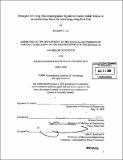| dc.contributor.advisor | Woodie Flowers. | en_US |
| dc.contributor.author | Lin, Elizabeth C | en_US |
| dc.contributor.other | Massachusetts Institute of Technology. Dept. of Mechanical Engineering. | en_US |
| dc.date.accessioned | 2007-02-21T13:22:57Z | |
| dc.date.available | 2007-02-21T13:22:57Z | |
| dc.date.copyright | 2006 | en_US |
| dc.date.issued | 2006 | en_US |
| dc.identifier.uri | http://hdl.handle.net/1721.1/36292 | |
| dc.description | Thesis (S.B.)--Massachusetts Institute of Technology, Dept. of Mechanical Engineering, 2006. | en_US |
| dc.description | Includes bibliographical references. | en_US |
| dc.description.abstract | This thesis describes the efforts to develop control strategies that use EMG signals from the anterior tibialis muscle to control ankle torque in an active ankle-foot orthosis. This would ultimately help rehabilitate persons affected by drop-foot gait, a condition which results in the loss of ability to dorsi-flex the ankle. This causes dropping of the toe during the swing phase of walking and "slapping down" of the foot after heel strike. Alleviation of these gait anomalies would improve mobility efficiency, safety, and cosmesis. Several types of orthotic devices fitted with springs and/or dampers have been used to control torque around the ankle and consequently facilitate the natural pattern of movement during the gait cycle. However, recent studies on powered upper-extremity orthoses controlled by EMGsignals from the users' impaired muscles have produced an unexpected and potentially exciting result. The use of EMG-controlled orthoses seems to improve the user's ability to control the compromised muscles and subsequently rebuild the connection between the brain and the output of those muscles. This could be a crucial step in helping stroke patients make a full recovery. | en_US |
| dc.description.abstract | (cont.) Extending this control scheme to a powered ankle orthosis requires understanding the relationship between ankle torque and EMG signals measured on the muscles likely to serve as control signal sites. Studies have shown that the muscle whose deterioration is most responsible for drop foot gait is the tibialis anterior. Thus, this thesis focuses on the relationship between EMG from the tibialis anterior and ankle torque. Experiments show that there is a clear pattern of EMG peak periods and silent periods throughout the gait cycle. However the magnitudes of these peaks are very similar and thus require a revision in the EMG control strategy used in the upper extremity orthoses which output a position of the brace via the EMG profile of the muscles around it. The control strategies devised involve using other inputs in addition to EMG, including foot switches and position sensors, to supplement the EMG control scheme in a new version of an active ankle foot orthosis. | en_US |
| dc.description.statementofresponsibility | by Elizabeth C. Lin. | en_US |
| dc.format.extent | 39 leaves | en_US |
| dc.language.iso | eng | en_US |
| dc.publisher | Massachusetts Institute of Technology | en_US |
| dc.rights | M.I.T. theses are protected by copyright. They may be viewed from this source for any purpose, but reproduction or distribution in any format is prohibited without written permission. See provided URL for inquiries about permission. | en_US |
| dc.rights.uri | http://dspace.mit.edu/handle/1721.1/7582 | |
| dc.subject | Mechanical Engineering. | en_US |
| dc.title | Strategies for using electromyographic signals to control ankle torque in an active joint brace for alleviating drop-foot gait | en_US |
| dc.title.alternative | Strategies for using EMG signals to control ankle torque in an active joint brace for alleviating drop-foot gait | en_US |
| dc.type | Thesis | en_US |
| dc.description.degree | S.B. | en_US |
| dc.contributor.department | Massachusetts Institute of Technology. Department of Mechanical Engineering | |
| dc.identifier.oclc | 77564532 | en_US |
